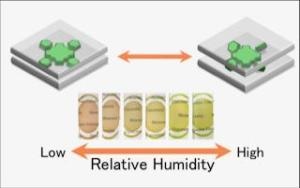May 17 2018
Scientists at Tokyo Metropolitan University and Shimane University have developed a transparent hybrid film that blends dyes and natural clay minerals to form a material which has the ability to change its color as a response to environmental humidity.
 Transparent hybrid film composed of environmentally friendly clay minerals and dyes, that changes color with humidity via a novel mechanism. (Image credit: Shinsuke Takagi)
Transparent hybrid film composed of environmentally friendly clay minerals and dyes, that changes color with humidity via a novel mechanism. (Image credit: Shinsuke Takagi)
During this color change, chemical bonds are not broken; the researchers revealed an innovative mechanism that renders the process easily reversible, for enduring functionality with the help of eco-friendly materials. Applications of the film include environmental sensors and advanced light amplification in displays.
The approach of combining dyes with a broad array of natural minerals such as zeolites (porous rock) and clathrates (clays) is a largely used, propitious method for developing hybrid materials with the ability to interact with light or “chromic” materials. A vital role is played by the physical structure of these materials; very small, nano-sized cavities allow the passage of light-sensitive molecules that act differently from the time they are free in solution, with prospective applications such as innovative sensors, light harvesting (such as in solar cells), and light emitting devices.
A research team headed by Professor Takuya Fujimura from the Department of Physics and Materials Science, Shimane University, and Professor Shinsuke Takagi from the Department of Applied Chemistry, Tokyo Metropolitan University, have developed a transparent film by using an eco-friendly clay mineral and magnesium porphyrin, a dye, which changes color as a response to humidity.
The film is rendered special by the mechanism through which it realizes a remarkable change. The structure of clays is layered, where nano-scale thin spaces are distributed in between. The researchers achieved a technical advancement in filling the dye into these spaces and arresting the formation of aggregates, to guarantee an effective response. The spacing of the clay layers changes as a response to humidity, thereby changing the confinement of the dye. To be more specific, the electrons enveloping the dye molecule, specifically those that take part in the way it interacts with light, are made to be in line with specific chemical groups in the clay, which drastically changes its color. It has to be noted that chemical bonds are not made or broken. This renders the film highly compatible with repeated switching, with a decrease in material degradation.
Not only the durability of the film is improved, but the dye and the clay could be naturally extracted materials. This relates to improved compatibility with the environment, enhanced safety, and lower cost. The researchers believe that the film and the innovative mechanism can be applied to sensors and amplification in light emitting devices.
A JSPS Grant-in-Aid for Scientific Research (B) (No. 24350100) and a JSPS Grant-in-Aid for Scientific Research on Innovative Areas “All Nippon Artificial Photosynthesis Project for Living Earth” (AnApple, No. 25107521) partially supported this study. The article in which this discovery is reported has been published online in Langmuir.